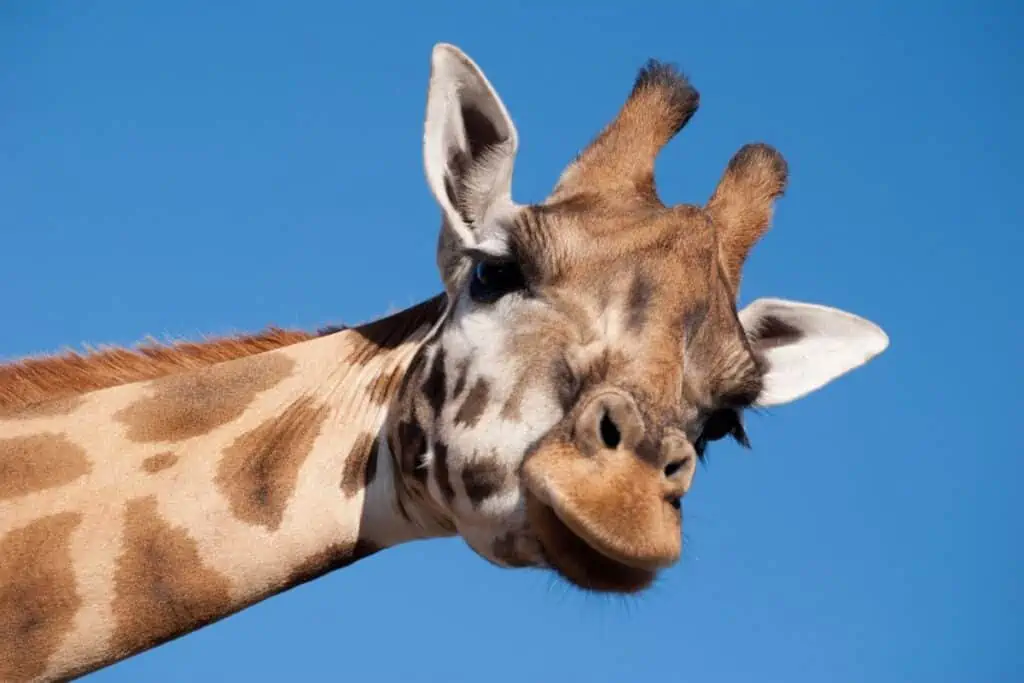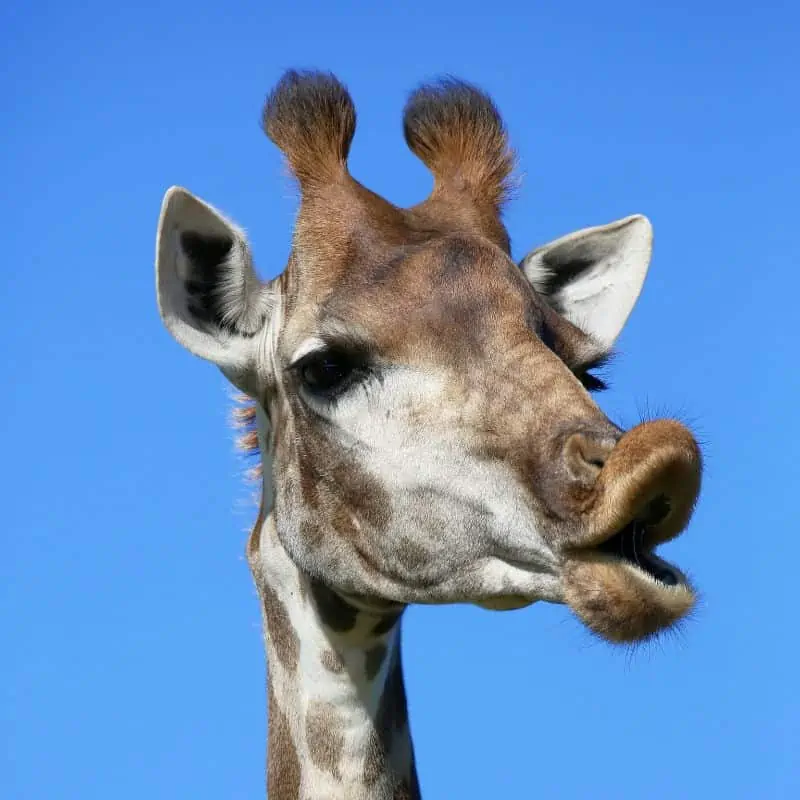There are many animals out there that are known for the noises they make, like cows that moo or dogs that bark. Giraffes, however, aren’t known for a particular noise, so what sound does a giraffe make then?
Giraffes can make quite a wide range of noises, although they rarely do so. Giraffes can hum, hiss, snort, grunt, snore, moo, bleat, whistle, and even bellow. They are generally very quiet creatures, but that doesn’t mean they are incapable of such vocalizations – they just don’t often make them.
Let’s look at these different giraffe sounds and when/why these massive creatures could make them.

What noises do giraffes make?
As mentioned above, giraffes can make an enormous range of different noises. Their vocal cords are perfectly capable of producing sounds, and they can adjust the shape of their mouths and the position of their tongues to affect how these sounds come out.
A giraffe has an amazingly versatile range of sounds, including:
- Grunting
- Snorting
- Hissing
- Humming
- Whistling
- Bleating (generally only in giraffe calves)
- Bellowing
- Mooing
- Coughing
That is a big range, although you could work with giraffes for years and rarely hear a sound.
Giraffes don’t make a particularly distinctive noise, which may be why no sound is associated with their species (like cats are associated with meowing). All of the noises above are more commonly associated with other animals.
When a giraffe does make a sound, it can be quite startling. They are large animals, so they are capable of making surprisingly loud noises when they choose to. Their general silence makes it more surprising when they suddenly decide to be vocal.
If you have heard a giraffe bellow, you’ll know what a shocking experience it can be.
Despite all that, giraffes are notorious for being quiet creatures that hardly ever make any noise. If you do hear a giraffe making a sound, it’s far more likely a giraffe calf calling for its mom.
In general, they communicate through body language; they might stomp their feet, toss their heads, wave their manes, and flick their ears. With sharp eyes, they can see these signs over long distances.
What do the different sounds mean?

Because giraffes so rarely vocalize, it has been very difficult for scientists to ascertain what the different noises mean and what prompts a giraffe to use its voice instead of its body when it wants to communicate.
Most of our understanding of what the different noises might mean is based on guesswork rather than proven studies.
Hissing is generally considered a sign of irritation or a warning of danger. Females sometimes hiss at their young, and males might hiss at each other.
Snorting and grunting may also be negative, but these sounds are usually made in response to perceived danger. Sometimes males will grunt at each other when competing for a female’s attention.
Coughing is also thought to indicate competition.
Bellowing is usually done when a female searches for her calf and tries to call it back to her. She may also whistle because long, sharp sounds carry well across open areas where giraffes are often found.
It isn’t currently thought that adult giraffes tend to communicate through whistling; this is almost always done with a young giraffe.
Many of the other noises mentioned above are made by babies – such as bleating.
This may be the baby’s means of communicating with its mother or making sure that she can locate it, or it might be calling for food.
As giraffes age, giraffes generally stop vocalizing as often and communicate more through body language. You might hear a juvenile cough or bleat, but adults very rarely do.
What causes adult giraffes to make noises?
Adult giraffes are generally silent, so you might wonder what prompts them to suddenly make a sound. The answer is usually that they are startled due to perceived danger and perhaps warning others of it.
Alternatively, males may make noises to warn others off and try to assert their dominance.
Overall more studies are needed to better understand how giraffes use sound.
Why and when do giraffes hum?
You may have heard that giraffes can hum, noted from a study done in 2015, where researchers discovered that giraffes separated into different stalls in a zoo emitted a low humming noise – perhaps so that their companions could hear them and knew that they were nearby.
Giraffes may do this when it’s dark because visual communication becomes harder.
The sounds were surprisingly harmonic and sustained, although it isn’t known if all the giraffes were making the noises or only some.
It also isn’t clear what purpose these sounds served. The giraffes likely reassured each other that they were still nearby or communicating about their position, but this isn’t known for certain.
In the wild, these sounds might have helped an individual who had been separated from the herd to find the others in the darkness.
Remember, giraffes are active during the day, so finding the others in the dark might otherwise prove very challenging, and a lone giraffe could be at risk of predation.
More research is needed to properly understand the purpose of humming in the giraffe world, but this curious sound appeals to human curiosity.
Some studies also indicate that giraffes might make a sound below humans’ hearing range. This is not the same as humming and could serve any purpose, from locating each other to passing on information about food.
Final thoughts on the sounds giraffes make
Giraffes were once considered silent creatures, but they make many sounds, especially young ones.
They can communicate among themselves and may even be able to communicate with a lost member of the herd by humming at night.
Furthermore, they may emit low-frequency noises that humans cannot hear, which raises some fascinating questions about giraffe communication.
